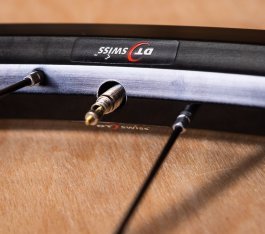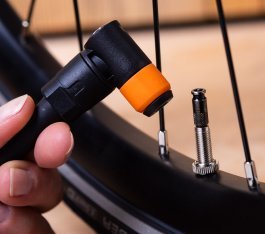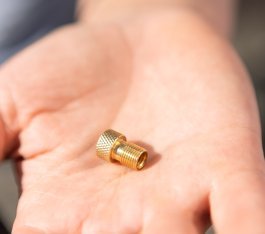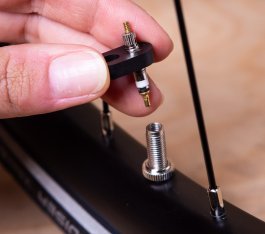
The ultimate guide to winter commuting
Cycling through autumn and winter: motivation, gear and safety tips. We’ll show you how to get yourself and your bike ready for the cold season.
Our guide explains the main bicycle valve types and their differences – from classic Presta to the innovative Schwalbe Clik Valve.
Small parts – big task. Valves are essential for all kinds of bicycles and e-bikes. But what’s behind the different designs? For over 100 years, Sclaverand (Presta), Schrader and Dunlop valves have been around. In 2024, the Schwalbe Clik Valve was introduced. What they all have in common: they let air into the inner tube or tyre, keep it there and allow it to be released when needed. Some are mounted directly in the rim as tubeless valves. Most are part of an inner tube. In terms of installation, handling and other details, there are differences that can be important depending on the intended use. Here we present the most important bicycle valve types in brief.
Amidst the jumble of different tubes and valves, it’s easy to get lost. In this article, we explain which valve types exist and how they differ. © bc GmbH
Before we look at the valve types in detail, here are a few quick recommendations to help you choose the best one for your needs:
The most common valve on high-quality and sports bicycles is the French valve, also known as the Sclaverand valve (SV), Presta valve or racing valve. It is quite narrow and fits into rims with a 6.5 mm drilling, which is the standard for high-quality rims. However, tubes with Presta valves can also be mounted in rims with larger holes. Most tubeless valves are Presta valves.
To inflate a Presta valve, you need to open it by unscrewing the small knurled nut at the tip before attaching the pump head. Almost all bicycle pumps are compatible. If you want to inflate your bike at a petrol station, an adapter will help. One of the major advantages of the Presta valve is the ability to release air precisely: simply press your finger on the opened nut. This even works with gloves. Don’t forget to close the valve again after inflating or adjusting the pressure!
The valve core is screwed into the valve stem on tubeless valves and most tubes, which has two advantages: firstly, the core can easily be replaced with a small tool if it gets bent or damaged. Secondly, you can extend the Presta valve length for high rims by adding an extension.
The classic and go-to choice for road and mountain bikes remains the Presta valve (SV). © bc GmbH

With the right locknut, you can install thin valves in large holes. © bc GmbH

© bc GmbH
The Schrader or car valve (AV) is less common on bicycles than the SV, but popular among some riders due to its robust design. Another advantage: it can be inflated at almost any petrol station. The valve stem is noticeably thicker compared to Presta valves, and no delicate valve core sticks out. To mount a tube with a Schrader valve, you need a rim with a wider 8.5 mm drilling. Most high-quality rims do not have this.
To inflate a tube with a Schrader valve, simply push or screw the pump head of your air pump (or the petrol station compressor) onto it and start pumping. A pin inside the pump head presses down a small plunger inside the valve and opens it. As soon as you remove the pump head, the mechanism closes again. To release air, you need a small object to briefly press down the plunger in the valve. A small hex key works well.
The valve core of a Schrader valve can also be removed and replaced. You will need the appropriate tool for this.
The car valve is also used in another area of bicycles: it is the standard on suspension forks and shocks (air-sprung components), where it reliably withstands very high air pressures.
The Schrader or car valve is robust and reliable and is still common on many bikes, e-bikes and cargo bikes. Road and mountain bikes are exceptions. © bc GmbH
The Clik Valve was introduced in 2024 by Schwalbe and carries the abbreviation SCV. It is a new type of bicycle valve designed with user-friendliness in mind. The Clik Valve has the same outer diameter as a Presta valve, so it also fits rims with a small 6.5 mm drilling. It combines the slim profile of Presta with improved airflow and simplified handling.
For inflation, a Clik Valve pump head or adapter works best. It is simply pushed onto the valve and clicks into place. Unlike traditional valve pump heads, you don’t need to flip a lever, screw, or hold anything in place. Just like with Schrader, a plunger in the valve is pressed down to open it. Once you finish pumping, simply pull off the head and the valve closes again – practically without air loss. Many clamp-on pump heads for Presta also work directly on Clik Valve without an adapter, while screw-on pump heads do not fit. Releasing air works similarly to Schrader: press the plunger in the valve with your fingernail, the edge of the valve cap, or another small object!
Schwalbe Clik Valve can be retrofitted to most tubes (SV, AV, and DV) and tubeless valves. You can find detailed instructions and more information in our deep dive: Testing the Schwalbe Clik Valve
Fairly new and very user-friendly: the Schwalbe Clik Valve. © bc GmbH

The Schwalbe Clik Valve (SCV) has only been around since 2024. © bc GmbH
You usually only find Dunlop valves on old or very inexpensive bicycles. They are also known by the abbreviation DV, as bicycle valve, Blitz valve or Woods valve. The valve stem has the same thicker diameter as Schrader, which means tubes with Dunlop valves only fit rims with a larger 8.5 mm drilling. For installation, the valve has to be unscrewed, as its lock nut does not pass through the rim.
Once mounted, the Dunlop valve is easy to inflate: place the pump head, clamp it if necessary, and start pumping. To release air, you can only slightly loosen the lock nut. With some practice, this can be done gradually, but it is nowhere near as precise as with the Presta valve. With a simple valve adapter (DV to AV), you can also inflate Dunlop valves at a petrol station.
The valve core of a tube with Dunlop valve can easily be replaced if it becomes leaky or damaged. To switch from Dunlop to Presta, however, the entire tube must be replaced.
Dunlop valves bring back childhood memories. The best part of this standard is how easily it can be converted to another type. © bc GmbH
Since inflating tubeless systems requires as much air as possible to pass quickly through the valve so that the tyre seals onto the rim, some manufacturers have developed their own solutions optimised for maximum airflow. Examples include the Reserve Fillmore, e*thirteen Quick Fill and Muc-Off Big Bore. Tubeless valves from Milkit are designed for easy refilling of sealant.
Not new, but rather uncommon, is the Regina valve. Its design is similar to the Presta valve, and you may come across it in Italy if you have a closer look at local bikes while on holiday.
Tubeless valves are usually Presta standard, but can also be converted to Clik Valve. Some valve caps also double as core removers. © bc GmbH
With a valve adapter you can use a pump head that would normally not fit your valve type. Common are adapters from SV or DV to AV, which allow you to use the compressor at a gas station. Many riders leave such an adapter permanently on the valve instead of a cap. Simple valve caps are usually included with inner tubes and tubeless valves. They protect the valve from dirt, regardless of its type. With colourful tuning valve caps, you can add two small highlights to your bike. There are also caps that double as tools for removing the valve core. Small tools for this purpose are also available separately or as part of multitools. The tight fit of the valve cores should be checked from time to time.
Since valve cores for both Presta and Schrader valves are inexpensive and take up little space, we recommend carrying a spare that fits your bike in your tool bag.
© bc GmbH

With an adapter like this, you can quickly inflate your valves at a petrol station! © bc GmbH

Valve cores are light, inexpensive and have saved many a bike ride! © bc GmbH
